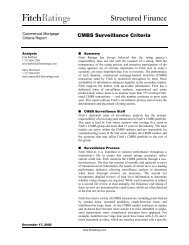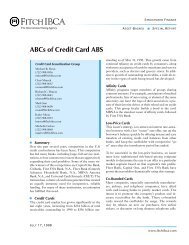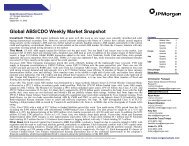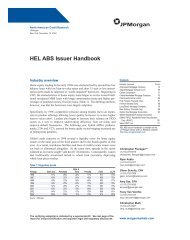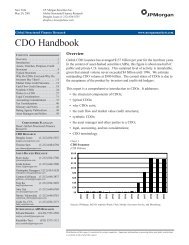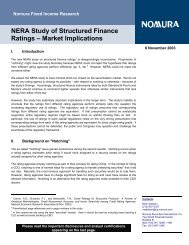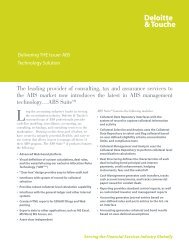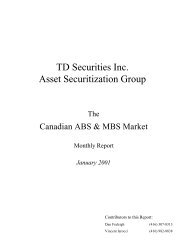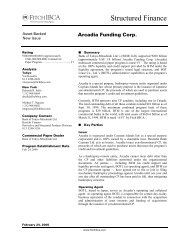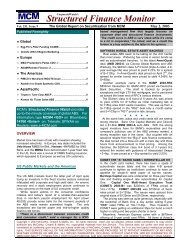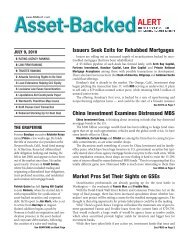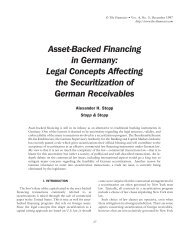Securitization Glossary - Securitization.Net
Securitization Glossary - Securitization.Net
Securitization Glossary - Securitization.Net
Create successful ePaper yourself
Turn your PDF publications into a flip-book with our unique Google optimized e-Paper software.
Nomura Fixed Income Research<br />
PAC Cash Flow/PACのキャッシュフロー<br />
Base Case / 基 本 のケース<br />
PAC Cash Flow /<br />
PACのキャッシュフロー<br />
Lower Band / 下 限<br />
Upper Band / 上 限<br />
Companions /<br />
コンパニオン 債<br />
PAC F<br />
PAC E<br />
PAC C<br />
PAC A<br />
Fast Case / 返 済 速 度 が 早 い 場 合<br />
Companions / コン<br />
パニオン 債<br />
PAC F<br />
PAC E<br />
PAC C<br />
Slow Case / 返 済 速 度 が 遅 い 場 合<br />
Companions / コンパニオン 債<br />
PAC F<br />
PAC E<br />
PAC C<br />
PAC A<br />
PAC A<br />
prepayment – payment of principal on a loan before its due date.<br />
Prepayments can occur on virtually any type of loan, but are<br />
most significant with respect to residential mortgage loans.<br />
Prepayments happen for many reasons but the two most<br />
important are refinancing and housing turnover. A refinancing<br />
prepayment occurs when a homeowner pays off his mortgage<br />
loan with the proceeds of a new loan. Often, the homeowner's<br />
motivation for getting a new loan is that he can get a lower<br />
interest rate on his new loan than he had on his old loan.<br />
Sometimes the homeowner's reason for refinancing is to borrow<br />
more money. For example, if the outstanding balance of a<br />
homeowner's loan is $100,000 and the value of his home is<br />
$200,000, the homeowner might pay off the old loan to take out<br />
a new loan in the amount of $150,000. Such a loan is called a<br />
"cash out" refinancing because the homeowner takes cash out<br />
of his home. A housing turnover prepayment happens when a<br />
homeowner sells his home. Most conventional mortgage loans<br />
include a "due on sale" clause, which requires the borrower to<br />
repay the entire amount of the loan upon the sale of the related<br />
home. A partial prepayment of a loan is called a "curtailment."<br />
prepayment rate; prepayment speed – describes the pace at<br />
which the mortgage loans underlying an MBS are prepaid by<br />
their borrowers. For purposes of measuring and describing the<br />
pace of prepayments, MBS professionals use two standardized<br />
models. The first, called "constant prepayment rate" or CPR<br />
expresses the pace of prepayments in terms of a constant<br />
annual rate of prepayment that would produce a measured<br />
change in outstanding principal over the interval of<br />
measurement. The second, called PSA (named for the Public<br />
Securities Association, the predecessor to the Bond Market<br />
Association), is based on the CPR model. The base case of the<br />
PSA model (i.e., 100% PSA) is defined as follows: prepayments<br />
are 0.2% CPR in the first month following origination of a pool of<br />
mortgage loans and increase by 0.2% CPR per month until they<br />
reach a steady-state rate of 6% CPR in the 30 th month.<br />
期 限 前 返 済 ; 期 限 前 償 還 ; 早 期 償 還 ; 繰 上 償 還 ; プリペイメント<br />
- 返 済 期 日 が 来 る 前 にローン 元 本 を 返 済 すること。あらゆる 種 類<br />
のローンに 関 して 起 こりうるが、 住 宅 用 モーゲージ・ローンにおいて<br />
最 も 重 要 な 意 味 を 持 つ。ローン 借 り 換 えによる 期 限 前 返 済 は、 債 務<br />
者 が 新 しいローンを 借 りて 古 いローンを 返 済 する 際 に 発 生 する。こう<br />
した 借 り 換 えは、 低 金 利 ローンへの 乗 り 換 えによる 金 利 節 約 が 動 機<br />
となっていることが 多 い。 一 方 、 借 入 額 を 増 やすために 借 り 換 えが 行<br />
なわれる 場 合 もある。 例 えば、 当 初 のローン 残 高 が 10 万 ドルとし、<br />
持 ち 家 の 価 値 が 20 万 ドルとすると、 債 務 者 は 古 いローンを 返 済 して<br />
新 たに 15 万 ドルを 借 り 入 れることもできる。こうした 借 り 換 えは、 住<br />
宅 を 担 保 に 債 務 者 が 現 金 を 手 にすることから、「キャッシュ・アウト」と<br />
呼 ばれる。さらに、 住 み 替 えのため 持 ち 家 を 売 却 する 場 合 にも、 期<br />
限 前 返 済 が 発 生 する。 従 来 型 のモーゲージ・ローンでは、そのほと<br />
んどで「 売 却 時 の 完 済 」が 義 務 付 けられており、 債 務 者 は 住 宅 売 却<br />
時 にローンを 全 額 返 済 しなければならない。 一 方 、 一 部 元 本 のみを<br />
期 限 前 返 済 する 場 合 は、「カーテイルメント( 一 部 返 済 ・ 内 入 れ)」と<br />
呼 ばれる。<br />
期 限 前 返 済 速 度 ; プリペイメント 速 度 - MBS の 裏 付 けとなってい<br />
るモーゲージ・ローンが 繰 り 上 げ 返 済 されるペースのこと。 期 限 前 返<br />
済 を 測 る 尺 度 としては、2つのモデルが 広 く 使 われている。 一 つ 目 は<br />
「CPR」と 呼 ばれ、 一 定 期 間 における 返 済 額 と 元 本 残 高 の 比 率 を 年<br />
換 算 したものである。 二 つ 目 は、 米 債 券 市 場 協 会 (BMA)の 前 身 で<br />
ある 公 共 債 協 会 (PSA)にちなんで「PSA」と 呼 ばれており、CPR モ<br />
デルをベースにしている。PSA の 基 本 モデル(100%PSA と 呼 ばれ<br />
る)では、モーゲージ・ローンの 発 行 から1ヶ 月 目 の 期 限 前 返 済 速 度<br />
を 0.2%CPR とし、その 後 これが 毎 月 0.2%ずつ 上 昇 し、30 ヶ 月 目<br />
に 6%CPR に 達 したところで 一 定 となると 想 定 する。PSA では 基 本<br />
モデルの 倍 数 として 返 済 速 度 が 表 現 され、 例 えば 200%PSA とは、<br />
毎 月 の 期 限 前 返 済 が 100%PSA モデルの 2 倍 の 水 準 で 推 移 する<br />
ケースを 指 す。( 詳 しくは 下 の 表 を 参 照 。)<br />
(17)



